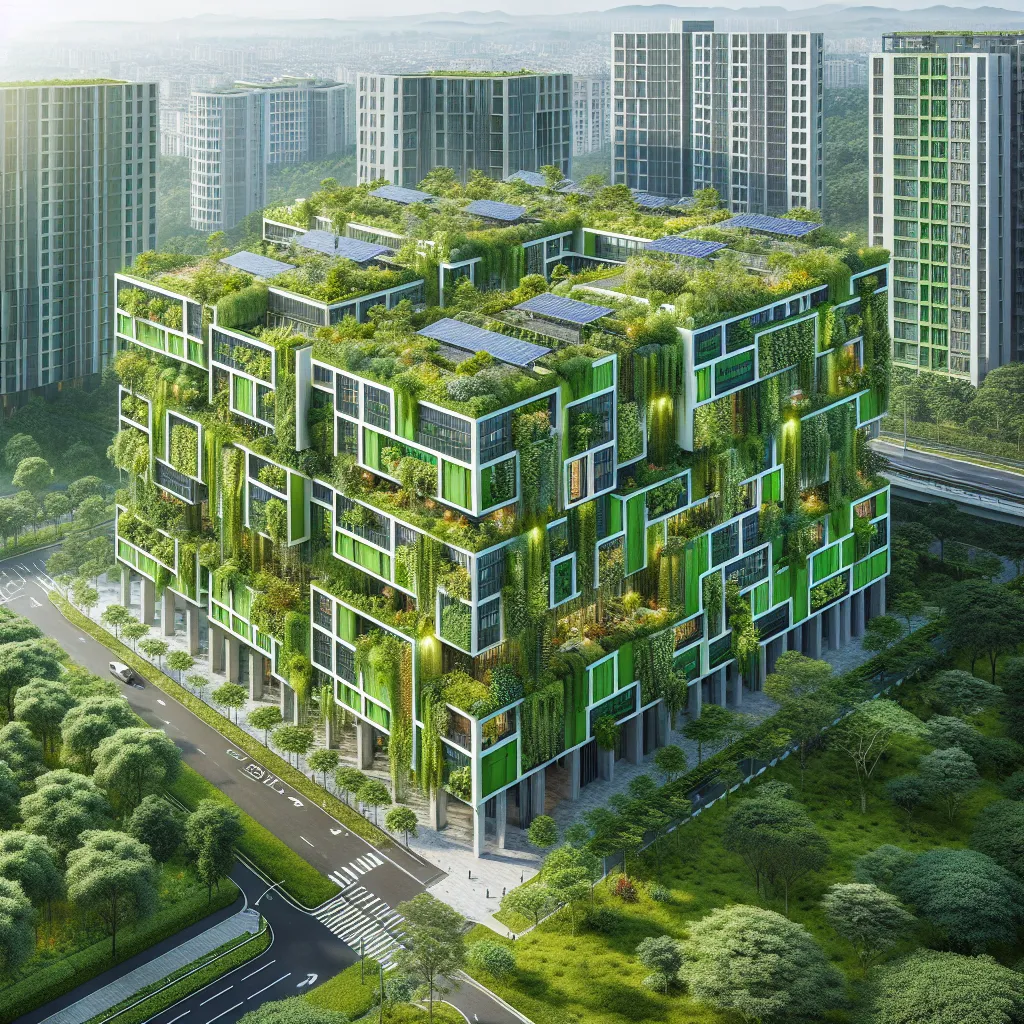Welcome to our IELTS Reading practice session focused on the topic of “How green buildings contribute to environmental sustainability.” This comprehensive practice test will help you prepare for the IELTS Reading section while exploring an important environmental topic. Let’s dive into the passages and questions to enhance your reading skills and expand your knowledge about sustainable architecture.
 Green building sustainability
Green building sustainability
Passage 1 – Easy Text
The Rise of Green Buildings
Green buildings have become increasingly popular in recent years as a response to growing environmental concerns. These structures are designed to minimize their impact on the environment while providing comfortable and efficient spaces for occupants. The concept of green buildings encompasses various aspects of construction and operation, including energy efficiency, water conservation, and the use of sustainable materials.
One of the primary ways green buildings contribute to environmental sustainability is through reduced energy consumption. This is achieved through a combination of passive design strategies and advanced technologies. For example, many green buildings incorporate large windows and skylights to maximize natural light, reducing the need for artificial lighting during daylight hours. Additionally, high-quality insulation and energy-efficient heating, ventilation, and air conditioning (HVAC) systems help maintain comfortable temperatures while minimizing energy use.
Water conservation is another crucial aspect of green building design. Low-flow fixtures, such as faucets and toilets, significantly reduce water consumption. Some buildings even incorporate rainwater harvesting systems to collect and reuse rainwater for irrigation and non-potable uses, further reducing the demand for freshwater resources.
The materials used in green buildings are carefully selected to minimize environmental impact. Sustainable and recycled materials are often preferred, and efforts are made to source materials locally to reduce transportation-related emissions. Furthermore, green buildings are designed with longevity in mind, utilizing durable materials and construction techniques that extend the building’s lifespan and reduce the need for frequent renovations or replacements.
By incorporating these features, green buildings not only reduce their environmental footprint but also create healthier and more productive spaces for occupants. As awareness of environmental issues continues to grow, the adoption of green building practices is likely to increase, contributing significantly to global sustainability efforts.
Questions 1-5
Do the following statements agree with the information given in the reading passage?
Write:
TRUE if the statement agrees with the information
FALSE if the statement contradicts the information
NOT GIVEN if there is no information on this
- Green buildings are designed to have a minimal impact on the environment.
- Natural lighting is used in green buildings to reduce the need for artificial lighting.
- Green buildings always use solar panels for energy generation.
- Rainwater harvesting systems are used in some green buildings to conserve water.
- Green buildings are more expensive to construct than traditional buildings.
Questions 6-10
Complete the sentences below.
Choose NO MORE THAN THREE WORDS from the passage for each answer.
- Green buildings use __ and advanced technologies to reduce energy consumption.
- High-quality insulation helps maintain comfortable temperatures while minimizing __.
- __ are used in green buildings to reduce water consumption.
- Green buildings often use __ to minimize environmental impact.
- Green building practices create healthier and more __ spaces for occupants.
Passage 2 – Medium Text
The Environmental Benefits of Green Buildings
The construction and operation of buildings have a significant impact on the environment, accounting for a substantial portion of global energy consumption and greenhouse gas emissions. Green buildings, also known as sustainable buildings, offer a solution to mitigate these environmental challenges. By incorporating innovative design features and technologies, green buildings contribute to environmental sustainability in various ways.
One of the most notable contributions of green buildings is their role in reducing carbon emissions. Through energy-efficient design and the use of renewable energy sources, these structures significantly decrease their reliance on fossil fuels. Passive solar design techniques, such as optimal building orientation and the use of thermal mass materials, help regulate indoor temperatures naturally. Additionally, many green buildings incorporate photovoltaic panels and wind turbines to generate clean electricity on-site, further reducing their carbon footprint.
Green buildings also play a crucial role in conserving natural resources. Water efficiency is a key focus, with features such as greywater recycling systems and xeriscaping (landscaping designed to reduce water consumption) becoming increasingly common. These measures not only reduce water usage but also alleviate pressure on local water supplies and treatment facilities.
The use of sustainable materials in green buildings contributes to resource conservation and waste reduction. Recycled and upcycled materials are frequently used in construction, reducing the demand for new raw materials and diverting waste from landfills. Furthermore, green buildings are often designed with modular and adaptable components, allowing for easier renovation and reconfiguration in the future, thus extending the building’s lifespan and reducing waste associated with demolition and reconstruction.
Green buildings also have a positive impact on biodiversity and local ecosystems. Many incorporate green roofs and living walls, which provide habitats for local flora and fauna, help mitigate the urban heat island effect, and improve air quality by filtering pollutants. Some green buildings go even further by integrating wildlife corridors and preserving natural habitats on their grounds, contributing to the overall health of local ecosystems.
The benefits of green buildings extend beyond their immediate surroundings. By serving as living laboratories for sustainable technologies and practices, these structures drive innovation in the construction industry and inspire wider adoption of environmentally friendly building techniques. Moreover, the increased awareness and education associated with green buildings can lead to behavioral changes among occupants, fostering a culture of sustainability that extends into their daily lives.
As cities and communities around the world grapple with the challenges of climate change and resource depletion, green buildings stand as beacons of hope and progress. Their multifaceted approach to environmental sustainability not only reduces the negative impacts of the built environment but also actively contributes to the regeneration and protection of our planet’s ecosystems.
Questions 11-14
Choose the correct letter, A, B, C, or D.
-
According to the passage, green buildings contribute to reducing carbon emissions by:
A) Using only solar power
B) Incorporating energy-efficient design and renewable energy sources
C) Banning the use of all fossil fuels
D) Relying solely on wind turbines for electricity -
Which of the following is NOT mentioned as a way green buildings conserve natural resources?
A) Greywater recycling systems
B) Xeriscaping
C) Desalination plants
D) Use of recycled materials -
Green roofs and living walls in green buildings help to:
A) Increase property values
B) Provide habitats for local flora and fauna
C) Replace traditional heating systems
D) Eliminate the need for air conditioning -
The passage suggests that green buildings have a wider impact by:
A) Forcing all other buildings to be demolished
B) Reducing the need for new construction
C) Inspiring innovation and behavioral changes
D) Eliminating the construction industry
Questions 15-20
Complete the summary below.
Choose NO MORE THAN TWO WORDS from the passage for each answer.
Green buildings contribute to environmental sustainability in multiple ways. They reduce (15) __ through energy-efficient design and renewable energy use. Water conservation is achieved through features like (16) __ and landscaping designed to reduce water consumption. The use of (17) __ in construction helps conserve resources and reduce waste. Green buildings also support biodiversity by incorporating (18) __ and preserving natural habitats. They serve as (19) __ for sustainable technologies, driving innovation in the construction industry. Ultimately, green buildings foster a culture of (20) __ that extends beyond the building itself.
Passage 3 – Hard Text
The Holistic Approach of Green Buildings to Environmental Sustainability
The concept of green buildings has evolved significantly over the past few decades, moving beyond mere energy efficiency to encompass a holistic approach to environmental sustainability. This paradigm shift reflects a growing understanding of the intricate interdependencies between built environments and natural ecosystems. Modern green buildings are now designed to not only minimize their negative impacts but also to actively contribute to the regeneration of the environment.
At the forefront of this evolution is the concept of regenerative design, which seeks to create buildings that give more to the environment than they take. This approach goes beyond the traditional notion of sustainability, which often focuses on maintaining the status quo, to actively improve environmental conditions. Regenerative buildings might, for example, produce more energy than they consume, purify air and water for the surrounding community, or create habitats that enhance local biodiversity.
One of the key principles underpinning the success of green buildings in contributing to environmental sustainability is the integration of systems thinking. This approach recognizes that a building is not an isolated entity but part of a larger ecosystem. Consequently, green building design considers the entire life cycle of a structure, from the sourcing of materials to eventual demolition or repurposing. This holistic view allows for the optimization of resource use and the minimization of waste at every stage.
The embodied energy of materials used in construction has become an increasingly important consideration in green building design. This refers to the total energy consumed in the production, transportation, and installation of building materials. Advanced life cycle assessment (LCA) tools are now employed to evaluate the environmental impacts of different materials and construction methods, allowing architects and engineers to make informed decisions that minimize the overall carbon footprint of a building.
Green buildings are also at the forefront of implementing circular economy principles in the construction industry. This involves designing for disassembly and reuse, utilizing modular construction techniques, and incorporating materials that can be easily recycled or biodegraded at the end of their useful life. By closing the loop on resource use, green buildings significantly reduce the demand for raw materials and the generation of waste.
The contribution of green buildings to environmental sustainability extends to their role in urban resilience. As climate change leads to more frequent and severe weather events, green buildings are designed to withstand and adapt to these challenges. Features such as bioswales for managing stormwater runoff, cool roofs to mitigate the urban heat island effect, and passive survivability measures that allow buildings to remain habitable during power outages all contribute to making cities more resilient in the face of environmental challenges.
Moreover, green buildings are increasingly leveraging smart technologies and the Internet of Things (IoT) to optimize their performance and reduce resource consumption. Artificial intelligence (AI) and machine learning algorithms are being employed to analyze data from sensors throughout the building, allowing for real-time adjustments to heating, cooling, lighting, and other systems based on occupancy patterns and environmental conditions.
The impact of green buildings on environmental sustainability is not limited to their physical attributes. They also play a crucial role in raising awareness and educating the public about environmental issues. Many green buildings incorporate interactive displays and educational programs that engage occupants and visitors, fostering a deeper understanding of sustainability principles and encouraging environmentally responsible behaviors.
As the urgency of addressing climate change and environmental degradation intensifies, the role of green buildings in contributing to environmental sustainability becomes increasingly critical. By continuously pushing the boundaries of what is possible in sustainable design and construction, green buildings serve as catalysts for innovation and beacons of hope in the global effort to create a more sustainable and resilient built environment.
Questions 21-26
Complete the sentences below.
Choose NO MORE THAN TWO WORDS from the passage for each answer.
- The concept of green buildings has shifted to include a __ approach to environmental sustainability.
- __ aims to create buildings that contribute more to the environment than they take from it.
- Green building design uses __ to view a building as part of a larger ecosystem.
- The total energy used in producing, transporting, and installing building materials is referred to as __.
- Green buildings implement __ principles to reduce demand for raw materials and waste generation.
- __ and machine learning are used to optimize building performance based on data from sensors.
Questions 27-30
Choose FOUR letters, A-H.
Which FOUR of the following features are mentioned in the passage as contributing to urban resilience in green buildings?
A) Solar panels
B) Bioswales
C) Cool roofs
D) Vertical gardens
E) Passive survivability measures
F) Underground parking
G) Rainwater harvesting
H) Geothermal heating
Questions 31-35
Do the following statements agree with the claims of the writer in the reading passage?
Write:
YES if the statement agrees with the claims of the writer
NO if the statement contradicts the claims of the writer
NOT GIVEN if it is impossible to say what the writer thinks about this
- Regenerative design is more advanced than traditional sustainability approaches.
- Life cycle assessment tools are essential for minimizing a building’s overall carbon footprint.
- Green buildings are always more expensive to construct than conventional buildings.
- Smart technologies in green buildings can adjust systems based on occupancy patterns.
- The impact of green buildings on environmental sustainability is solely due to their physical attributes.
Questions 36-40
Complete the summary below.
Choose NO MORE THAN THREE WORDS from the passage for each answer.
Green buildings contribute to environmental sustainability through a holistic approach that goes beyond energy efficiency. They employ (36) __ to create structures that actively improve the environment. The design process incorporates (37) __, considering the building’s entire life cycle. Materials are chosen based on their (38) __ to minimize environmental impact. Green buildings also play a role in (39) __ by implementing features that help cities adapt to climate change. Furthermore, they serve an educational purpose by (40) __ about environmental issues and encouraging sustainable behaviors.
Answer Key
Passage 1
-
TRUE
-
TRUE
-
NOT GIVEN
-
TRUE
-
NOT GIVEN
-
passive design strategies
-
energy use
-
Low-flow fixtures
-
Sustainable and recycled materials
-
productive
Passage 2
-
B
-
C
-
B
-
C
-
carbon emissions
-
greywater recycling systems
-
recycled and upcycled materials
-
green roofs
-
living laboratories
-
sustainability
Passage 3
-
holistic
-
Regenerative design
-
systems thinking
-
embodied energy
-
circular economy
-
Artificial intelligence
-
B, C, E, G
-
YES
-
YES
-
NOT GIVEN
-
YES
-
NO
-
regenerative design
-
systems thinking
-
embodied energy
-
urban resilience
-
raising awareness
This IELTS Reading practice test on “How green buildings contribute to environmental sustainability” provides a comprehensive exploration of the topic while testing various reading skills. The passages progress from easier to more challenging texts, mirroring the structure of the actual IELTS Reading test. By practicing with this material, you’ll not only improve your reading comprehension but also gain valuable knowledge about sustainable architecture and its impact on the environment.
Remember to time yourself when taking this practice test to simulate real exam conditions. If you found certain questions or vocabulary challenging, take the time to review and learn from your mistakes. This will help you better prepare for the actual IELTS Reading test.
For more IELTS practice materials and tips on improving your reading skills, check out our other resources on the role of education in environmental conservation and the effects of urbanization on environmental sustainability. Good luck with your IELTS preparation!


